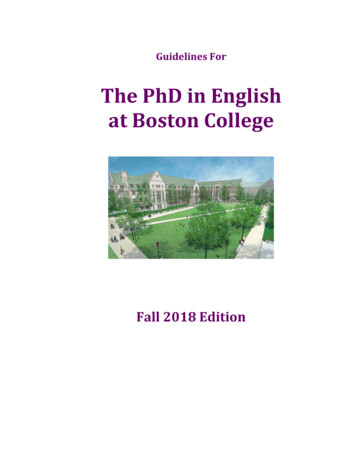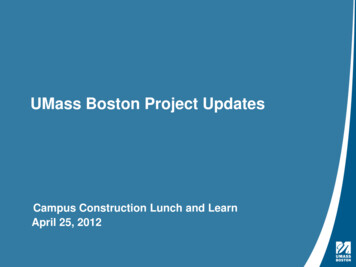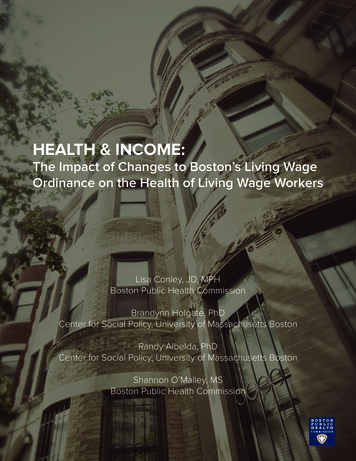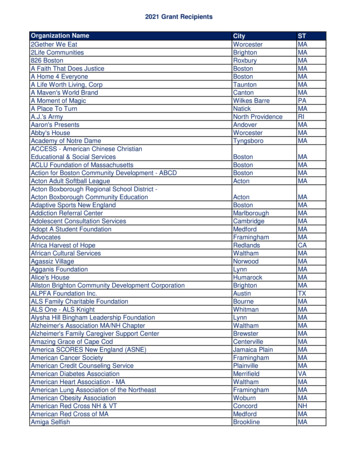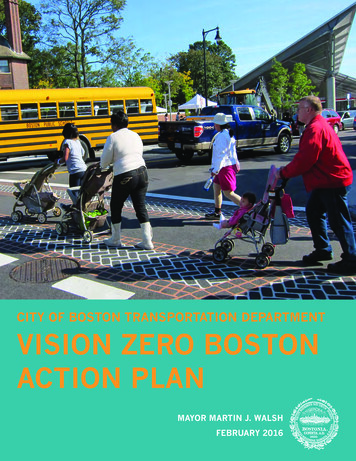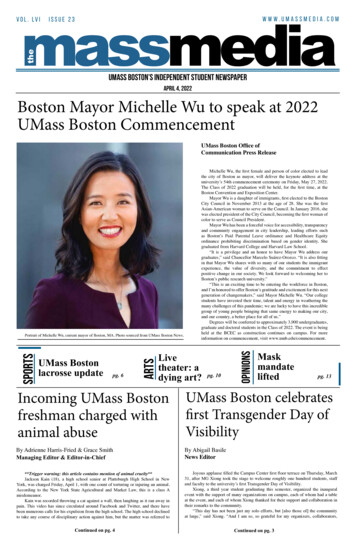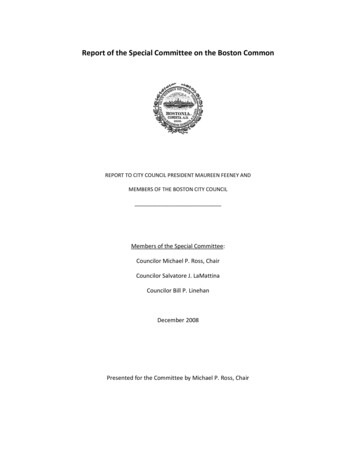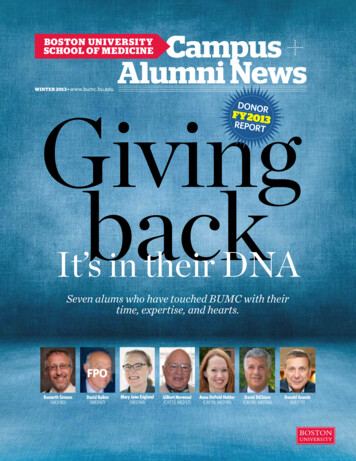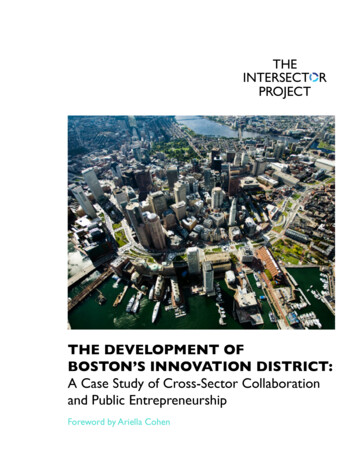
Transcription
THEINTERSECT RPROJECTTHE DEVELOPMENT OFBOSTON’S INNOVATION DISTRICT:A Case Study of Cross-Sector Collaborationand Public EntrepreneurshipForeword by Ariella Cohen
The Intersector ProjectWhat is the Intersector?Perhaps more than ever before, addressing common, knotty problems in our modern liferequires navigating across the government, business, and non-profit sectors.Yet sectorshave differing languages, cultures, and practices that make it challenging to work together.There is a need for a new sector, the intersector, a space where collaboration amonggovernment, business, and non-profit sectors enables leaders to share expertise,resources, and authority to address problems that cannot be solved by one sector alone.About The Intersector ProjectThe Intersector Project is a non-profit organization that seeks to empower practitionersin the government, business, and non-profit sectors to collaborate to solve problemsthat cannot be solved by one sector alone. We present real examples of collaborationsin many places, across many issues and illuminate the tools that make them successful.We do this through our library of forty case studies, which profile successfulintersector initiatives; our Toolkit, which draws from an extensive body of researchto provide practical knowledge to practitioners; and our ongoing research aimed atproviding meaningful analysis and practical insight into the growing space of intersectorcollaboration.Learn more at intersector.com.THEINTERSECT RPROJECTThe Development of Boston’s Innovation District2
Table of ContentsForeword . . . . . . . . . . . . . . . . . . . . . . . . . . . . . . . . . . . . . . . . . . . . . . . . . . . . . . . . . . . . . . . . . . . . . . . . . 4Introduction . . . . . . . . . . . . . . . . . . . . . . . . . . . . . . . . . . . . . . . . . . . . . . . . . . . . . . . . . . . . . . . . . . . . . . 6Background . . . . . . . . . . . . . . . . . . . . . . . . . . . . . . . . . . . . . . . . . . . . . . . . . . . . . . . . . . . . . . . . . . . . . . . 7A Mayor’s Vision . . . . . . . . . . . . . . . . . . . . . . . . . . . . . . . . . . . . . . . . . . . . . . . . . . . . . . . . . . . . . . . . . . . 8Mass Challenge: A Key Turning Point . . . . . . . . . . . . . . . . . . . . . . . . . . . . . . . . . . . . . . . . . . . . . . . 10Community Engagement and Communications Strategy . . . . . . . . . . . . . . . . . . . . . . . . . . . . .11The District Gains Momentum: Key Developments and Entrants . . . . . . . . . . . . . . . . . . . . 13District Hall: Boston’s First Public Innovation Center . . . . . . . . . . . . . . . . . . . . . . . . . . . . . . 15Current State of the District: Successes and Challenges . . . . . . . . . . . . . . . . . . . . . . . . . . . . .17The Role of the Public Sector . . . . . . . . . . . . . . . . . . . . . . . . . . . . . . . . . . . . . . . . . . . . . . . . . . . . . 18Key Issues and Lessons . . . . . . . . . . . . . . . . . . . . . . . . . . . . . . . . . . . . . . . . . . . . . . . . . . . . . . . . . . 21Conclusion: Future Visions of the District and of Innovation in Boston . . . . . . . . . . . . . . 23Method . . . . . . . . . . . . . . . . . . . . . . . . . . . . . . . . . . . . . . . . . . . . . . . . . . . . . . . . . . . . . . . . . . . . . . . . . . 25Endnotes . . . . . . . . . . . . . . . . . . . . . . . . . . . . . . . . . . . . . . . . . . . . . . . . . . . . . . . . . . . . . . . . . . . . . . . . 26Authors and Acknowledgments . . . . . . . . . . . . . . . . . . . . . . . . . . . . . . . . . . . . . . . . . . . . . . . . . . . 28The Development of Boston’s Innovation District3
ForewordBy Ariella CohenEditor-in-Chief, Next CityMy first post-college office was a converted loft inthe DUMBO section of Brooklyn. The year was 2004;the Internet was only then beginning to transform theway we live and work, yet big changes were afoot, andmy boss’s landlord, David Walentas, knew it.Twenty-five years earlier the real estate developerhad gambled 12 million on 2 million square feetof industrial property underneath the ManhattanBridge. It was a lot of money for a noisy warrenof half-empty warehouses and fetid cobblestonedalleys, but Walentas hunkered down for the long haulon the intuition that the neighborhood’s residentindustries were soon to change. By the time Iarrived on the scene with a job at an independentBrooklyn newspaper and a scrappy commuter bike,the warehouses were teeming with young computerprogrammers and MacBook-toting graphic designers.I encountered my first software entrepreneur on thecreaky freight elevator I rode up to my office everyday and drank my first locally brewed kombucha inthe overpriced grocery store on the building’s firstfloor. Eventually, both the software guy and the localkombucha made their way into my newspaper stories.To innovate is to disrupt the established orderand introduce something new. . The ideal endresult is the increased creative productionassociated with the kind of spontaneous crosssector interaction I experienced in DUMBO,not to mention new tax revenue and jobs.The Development of Boston’s Innovation DistrictWalentas didn’t call DUMBO an innovation district.He didn’t have to. The creative energy was palpablein the neighborhood’s narrow streets – and Walentashad subsidized the rents of enough startups, artists,and media types that no one was going anywhere elseanytime soon, anyhow.Eleven years later, Walentas has been made amillionaire many times over, and DUMBO is oneof the city’s wealthiest (and most Instagram-ready)neighborhoods, a mix of glassy multi-million-dollarcondo towers, hip offices, and posh commercecatering to residents with a median household incomeof 181,684. (By comparison, the median income forthe city as a whole is 50,711.)I still have a few artist and journalist friends who workin the neighborhood thanks to the discounted officespace that Walentas continues to provide in hope ofmaintaining the neighborhood’s buzz.Yet more andmore, the neighborhood feels like a study in luxuryurbanism. It’s lovely to visit but not a replicable oreven desirable model for most cities.To innovate is to disrupt the established order andintroduce something new. Brookings Institutionresearchers Bruce Katz and Julia Wagner describeinnovation districts as “physically compact, transitaccessible” mixed-use areas where “leading-edgeanchor institutions and companies cluster andconnect with startups, business incubators, andaccelerators.”1 The ideal end result is the increasedcreative production associated with the kind ofspontaneous cross-sector interaction I experienced in4
ForewordDUMBO, not to mention new tax revenue and jobs.These districts represent a mash-up of thedevelopment strategy that made a grittyneighborhood under a loud bridge desirable toentrepreneurs and wealthy condo-buyers, and anemerging model predicated on collaboration andgovernment involvement. Instead of Walentas’ oneman, market-driven show, they are the product oflong-term planning and shared investment on the partof taxpayers, anchor institutions, and private-sectorpartners.As with any public-private partnership, thesecollaborations carry risk but also the potential fornew public benefit. Where in the past a developer likeWalentas may have been held accountable for hiringlocally or building a minimal number of affordableunits mixed in with the luxury apartments – 58of them in the case of DUMBO – this new modelpresents an opportunity to plan strategically withpublic needs in mind and, ultimately, create a placethat reflects the interests of a diverse urban populace.In cities such as Pittsburgh, Detroit, Buffalo, St. Louis,and Boston, the model is being adapted to meetlocal needs with programs intended to foster amore inclusive ecosystem that will create economicopportunities not only for those already connected tothe tech sector but also those who need a way in. Inother words, these cities are seeking to do somethingtruly innovative: disrupt a pattern of inequality.the city’s reputation as a hotbed for tech-drivenentrepreneurship.Yet as the District continuesto grow, it faces new challenges of accessibility,affordability, and identity – challenges that can onlybe addressed through more collaboration and yes,innovation. Indeed, we are not in DUMBO anymore.Ariella Cohen is an award-winning journalistwith 11 years of experience reporting on urbanchange, politics, and policy. Prior to joining NextCity – a non-profit organization with a missionto inspire social, economic, and environmentalchange in cities through journalism and eventsaround the world – she co-founded New Orleans’first online investigative news outlet, The Lens,and worked as a staff reporter for the BrooklynPaper in New York. She has reported on disasterrecovery, urban development, and city politicsin Port-au-Prince, Jerusalem, and in cities acrossthe United States. Follow her @ariellacohen onTwitter.With this report, The Intersector Project offers aninsightful exploration of collaborations across thebusiness, government, and non-profit sectors in thecontext of the Boston Innovation District, one ofthe earlier examples of this emerging model for21st century economic development. Since 2010,more than 200 startups have set up shop in the area,creating hundreds of new jobs and contributing toThe Development of Boston’s Innovation District5
IntroductionThis study explores the relevance of intersector collaborations– collaborations across the business, government, and nonprofit sectors – in the context of the Boston InnovationDistrict.Emerging in urban centers across the country, citylevel innovation districts are geographically distinctareas intended to attract cutting-edge companies,research institutions, startups, accelerators, andother related entities, creating a dense community ofinnovators and entrepreneurs.2 Innovation districtsalso tend to attract businesses that offer supportservices to tenants (e.g. law, accounting, and publicrelations firms), as well as entities that offer amenities,such as restaurants and bars.Understanding how city-level innovation districts canharness the strengths of each sector is particularlyimportant in an era of urbanization, limited publicresources, and increased public expectations ofpublic sector innovation. The development of theBoston Innovation District provides an outstandingexample of a government-led economic developmentapproach involving collaboration across sectors. Italso demonstrates what Mitch Weiss, former Chiefof Staff to Boston Mayor Thomas Menino and now alecturer at Harvard Business School, has described as“public entrepreneurship.”3 Public entrepreneurshipis an approach to public sector management thatdraws upon a set of “lean” startup principles, includinghypothesis-based experimentation and testing,iterative learning, and speed, agility, and willingness topivot.The Development of Boston’s Innovation DistrictUnderstanding how city-level innovationdistricts can harness the strengths of eachsector is particularly important in an era ofurbanization, limited public resources, andincreased public expectations of public sectorinnovation.Following this approach, Boston’s public sector ledthe development of the District, an ecosystem ofinnovation and entrepreneurship.4 This economicdevelopment strategy aimed to revitalize anunderutilized parcel of land by attracting bothestablished companies and emerging entrepreneurs,and developing infrastructure and amenities toholistically support work-life opportunities – alllargely without the use of major tax incentives orcostly capital investments. Within this framework, theOffice of Mayor Menino (and subsequently the Officeof Mayor Martin J. Walsh) and supporting agenciescatalyzed investments and stakeholder engagementthat brought the District to life, breeding additionalcross-sector activity and partnerships along the way.6
BackgroundBoston’s distinctive concentration of higher educationinstitutions, research and manufacturing capabilities,and venture capital firms makes it uniquely positionedto attract extraordinary talent and innovativeventures. According to Entrepreneur magazine, as ofJanuary 2015, Boston was the top destination forventure capital investments in the United States, afterthe San Francisco Bay Area.5 These contextual factorscontribute to the city’s ability to promote dynamiceconomic growth.6The Boston Innovation District spans approximately1,000 acres and includes five sub-districts: Fort Point,Seaport, Port, Convention Center, and 100-Acres.It is most commonly known as the South BostonWaterfront or Seaport District and has a richhistory that dates back to the 19th century. It wasa wetland peninsula that was annexed to Boston in1804, when it became a hub of fast-growing industrialdevelopment.7 The area served as home to railyards and manufacturing companies for Boston’sworking port until about 1955. The developmentof transportation infrastructure, including elevatedhighways, isolated the District, making it hardlyaccessible by foot.Beginning in 1995, the extension of the MassachusettsTurnpike to Logan Airport and the opening of theTed Williams Tunnel made the area more accessibleand created opportunities for development. In 2004,the Seaport District was further integrated intodowntown Boston as the result of the project knownas the Big Dig that dismantled the elevated CentralArtery highway and rerouted Interstate 93 throughunderground tunnels.8 Shortly after, the expansion ofthe Massachusetts Bay Transit Authority’s Silver Linebrought public transportation to the area for the firsttime.9 2004 also marked the opening of the BostonConvention and Exhibition Center east of Fort Point,The Development of Boston’s Innovation DistrictDOWNTOWNBACK RICTSOUTH BOSTONNORTHDORCHESTERCourtesy of the Boston Redevelopment Authoritywhich transformed the area and drew in thousandsof new visitors. In 2005, Joe Fallon, founder of TheFallon Company, purchased 21 acres of waterfrontproperty in the District for a massive multi-buildingwaterfront development project to be known as theFan Pier Development, expected to create 3 billionworth of mixed-use development.10 The Instituteof Contemporary Art relocated to the Fan PierDevelopment and became the cultural cornerstoneand a centerpiece of Boston’s new waterfront. Giventhe significant changes in those years, the SeaportDistrict was dubbed a “bustling waterfront” by TheNew York Times in 2007.11The global economic downturn in 2008 disruptedthe area’s renaissance. While affordable rents in theDistrict helped the neighborhood continue to grow,large-scale development slowed during this period.By 2010, the District presented a mixed landscape,with newly built, vacant Class A office buildingsnext to empty factories, high-end apartments andcondominiums next to artist studios, and trendy barsnext to vast open parking lots.7
A Mayor’s VisionIn January 2010, during his fifth inaugural address,Mayor Thomas M. Menino officially declared his visionto redevelop the Seaport District into the “InnovationDistrict”:“A new approach is called for on thewaterfront – one that is both more deliberateand more experimental. Together, we shoulddevelop these thousand acres into a hub forknowledge workers and creative jobs. We’lldefine innovation clusters – in green, biotechand health care, web development, and otherindustries. And there, we’ll experiment withalternative housing models. We will test newideas that provide live/work opportunities toentrepreneurs and affordable co-housing forresearchers. .Years of financial engineeringleft us with a sub-prime crisis in housing. It’stime to get back to “engineering engineering.”We’ll give architects and developers thechallenge to experiment with new designs,new floor plans, and new materials. Ourmandate to all will be to invent a 21stcentury District that meets the needs of theinnovators who live and work in Boston –to create a job magnet, an urban lab on ourshore, and to harvest its lessons for the city.12Mayor Menino was first elected in 1993 and wasre-elected in 1997, 2001, 2005, and 2009. He was thelongest-serving mayor in Boston’s history and wasbeloved by many, maintaining a steady approval ratingof 72 percent from 2005 to 2008.13 He was known tobe affable and accessible, equally eager to participatein a ribbon cutting ceremony for a small business or amultinational corporation.Mayor Menino’s public declaration was a call to actionThe Development of Boston’s Innovation Districtfor his staff and City agencies to execute his vision ofa waterfront community of innovation. The Office ofthe Mayor and the Boston Redevelopment Authority(BRA), the urban planning and economic developmentagency for the City of Boston, took the reins incarrying out the Mayor’s vision. As Weiss (the formerChief of Staff) recalls, “[The Mayor] expressed a vision,but there was no plan per se.” There was a sense ofurgency, however, and a willingness to experiment byseizing opportunities for stakeholder engagement andrecruitment that left no time for extensive studies orcomplex assessment plans. As a BRA staff memberremembers, “At that point, we had the bare bones ofa strategy and a slight vision for what we wanted todo. Then, we built it along the way.”“[The Mayor] expressed a vision, but there wasno plan per se.” There was a sense of urgency,however, and a willingness to experimentby seizing opportunities for stakeholderengagement and recruitment that left no timefor extensive studies or complex assessmentplans.The Mayor’s vision for the District had four mainfeatures, which set the tone for how developmenttook shape.Industry-AgnosticClustersExperimentalCity as Host8
A Mayor’s VisionIndustry-Agnosticwork needs as an afterthought.”15 The underlyingOne of the main features of the District was toassumption was that attracting talent to work inbe open to industries of every kind. This allowedthe District was not enough for its sustainabilityfor broad inclusivity of established companies andas an innovation hub. The city needed to retainsmall enterprises and provided a framework fortalent through a work-life environment favorable tocommunity engagement. As Samantha Hammar, former creativity and exchange. Building physical spaces thatCommunications Strategist for the Boston Innovation enabled entrepreneurs to converge during and afterDistrict, notes, the message was clear: “If you identifywork hours became imperative for the public sector,as innovative, you are more than welcome. This iswhich led to the recruitment of accelerators, such asan inclusive community for innovative people.” ThisMassChallenge, and the development of public meetalso allowed the District to be less dependent on the up spaces, such as District Hall.growth of a single industry for its sustainability. Weissrecalls:ExperimentalThe third feature was the public sector’s adoptionof an experimental framework characterized byPicking winners and losers or pickingexpedited decision making and planning flexibility.[industries] just didn’t sit right with us,The mayor’s declaration sparked interest among thenumber one. Number two, we actually had nobusiness community and created momentum for themoney. This is 2010; there is no money. Thatpublic sector’s efforts to engage developers, designended up being actually very good, because asand architecture firms, company CEOs, entrepreneurs,soon as there is money, you are deciding whoand non-profit organizations to begin to constructto give it to. As soon as you are deciding whothe fabric of a community. As Weiss notes, “Moveto give it to, you are trying to come up withsmall, move fast; be a much more nimble [public]some framework about who [to] pick. Thatentrepreneur. That’s what we did. We never had anytakes time.budget. We never had any task force. We just wentand grabbed opportunistic things.”ClustersThe City as HostThe second feature in the creation of the Districtwas the desire to cluster innovative entrepreneurs to A fourth feature was to position the city as the hostinstitution instead of the host being a university orincrease proximity and density. This was highlightedresearch firm, as is the case with MIT in Kendallby the District’s motto “Work, Live, Play” and theSquare, for example. As BRA Director of Planningnotion that “people in clusters innovate at a quickerKairos Shen explains, “In the end, the city is the host,rate, sharing technologies and knowledge easier.”14not the institutions.” The identification of the DistrictFollowing this model, the City also hoped to attractwith the city meant that the neighborhood would beamenities that would entice entrepreneurs to spendfree to develop organically, create momentum, andmore time in the District networking and socializing.allow innovation to disperse across the city.After speaking with many entrepreneurs throughtown halls and other events, Mayor Menino presented10 items he considered key to the District’sdevelopment, one of which was “Don’t treat after“The Development of Boston’s Innovation District9
MassChallenge: A Key Turning PointTo build momentum around the Mayor’s vision,Menino’s team focused on identifying emergingcompanies looking for space that could be recruitedto the District. Weiss was informed by a member ofthe local tech startup community that MassChallenge,a promising young Boston-area accelerator, waslooking for space to expand. Founded in 2009 asa startup competition and mentorship program,MassChallenge had been using a small space in theCambridge Innovation Center near MIT and waslooking for a more permanent space to supportits expected growth. Both Weiss and the Mayorpersonally reached out to Akhil Nigam, the cofounder and President of MassChallenge, to sharetheir vision for the District and invite him to be apart of it. Eyeing thousands of square feet of officespace that was sitting unfilled in the District afterthe economic downturn, Mayor Menino encouragedreal estate developer Joe Fallon to provide freeoffice space for MassChallenge. Fallon offeredMassChallenge a one-year rent-free lease in his OneMarina Park Drive building, which successfully luredthe young non-profit to the District.16 The relationshipbetween Fallon and the Mayor appeared to be animportant factor in making this deal possible.entrepreneurs who previously had very little reasonto leave the entrepreneurial hub of Kendall Square.MassChallenge’s move to the area was amilestone, signaling to the community thatsomething new was happening in the District.MassChallenge’s leaders remained engaged with theMayor and his team to help shape the developmentof the District. Nigam helped organize severalroundtables for groups of 10-12 local entrepreneursto meet with the Mayor and provide input about theirneeds. More affordable housing, places to eat, eventspace, and non-Class A office space were at the topof their lists. Additionally, companies were lookingfor well-aligned talent, funding streams, and a worklife environment that would be agreeable to theiremployees. The Mayor committed to the developmentof more affordable housing and social infrastructure– including interesting spaces and events – that wouldbring the community together.MassChallenge’s move to the area was a milestone,signaling to the community that something new washappening in the District. MassChallenge CEO andco-founder John Harthorne notes the skepticism thatsurrounded the development: “Our arrival was verysignificant because at the time [the District] was stilllargely a vision, and it was still being questioned by themedia and the community.”17 With its 110 companiesand over 200 mentors, MassChallenge helped togenerate significant traffic to the District, hostingmore than 100 events in the first year with thousandsof participants. This flow of new traffic changedthe character of the District and helped to attractThe Development of Boston’s Innovation District10
Community Engagementand Communications StrategyAfter MassChallenge’s move, momentum continuedto build as the City engaged partners and communitymembers to develop social infrastructure for theDistrict. When asked how the team approachedmarketing the District, Weiss shared this insight intotheir strategy: “Not the old ways, not with a full-pagead in the newspaper or this and that. [Instead,] havesomebody [from our team] down in the District,hanging out, meeting people, just being in thecommunity.” The City also decided to avoid havinga designated office in City Hall and instead engagedwith the community via a social media manager whowould often spend time in the District “just havingcoffee, walking around, meeting people . and thendoing that electronically too.”“Not the old ways, not with a full-page adin the newspaper or this and that. [Instead]have somebody [from our team] down in theDistrict, hanging out, meeting people, just beingin the community.”While the Mayor discussed his ideas for the Districtwith business leaders, a small team from the Mayor’sOffice reviewed research to understand the currentclimate in the District and its potential. Based ontheir findings, the team developed a communicationscampaign that was disseminated through socialmedia and informal, volunteer “community brokers”– individuals who integrated themselves into thecommunity and worked largely autonomously tobuild connections with entrepreneurs to furtherunderstand their needs. Samantha Hammar, formerCommunications Strategist for the District, shares herthoughts on these early stages:The Development of Boston’s Innovation District“We were able to . really quickly startto show . these are the things that arealready happening down here, these are thecompanies that are down here, these are allthe people that are moving in, these are thesmall, yet really powerful companies that havemoved in here . and that . was where thecommunications effort really thrived.Community brokers played an integral role inmaintaining momentum and creating buy-in fromindividuals already working in the District, as well asthose searching for new space. For some communitymembers and partners, community brokers were thefirst point of contact and served to clarify what theCity was envisioning for the District.Although the City focused on engaging with theentrepreneur community, it also built ties withother key constituencies in the District, such as theartists of Fort Point. Beginning in the 1970s, artistshad converted abandoned industrial lofts in FortPoint into creative living and working spaces. By theend of the 1980s, they had formed the Fort PointArts Community, a non-profit organization focusedon promoting their work, providing studio space,and strengthening their community by organizingevents in the area. In the early 2000s, before MayorMenino articulated his vision for the District, theBoston Wharf Company, one of the key landlords forhundreds of these artists, sold its properties.18This precipitated a series of evictions as buildingsoccupied by artists were sold to other propertyowners. These evictions challenged the artists’ sense11
Community Engagement and Communications Strategyof leadership in their community and bred resentmentfor the redevelopment of their area. Despite theevictions and fight for artist-controlled buildings, therecontinued to be an established artist presence in theFort Point neighborhood.The artists became aware of the City’s plans forthe District around the same time that the businesscommunity was first engaged. Due to the history ofdisplacement, the City’s vision for the neighborhoodas a mixed-use, 24-hour community cateringto entrepreneurs raised fears among the artistcommunity of gentrification and increasing housingcosts. As part of the community engagement strategyfor the District, one of the community brokersengaged Friends of Fort Point Channel, a non-profitorganization established in 2004 in partnership withlandowners, non-profit leaders, and residents. Theorganization had a business committee that met everymonth at a different local business to network andcollaborate on issues and projects. The communitybroker began to attend these meetings, informingneighborhood partners of planned developmentsin the District, answering questions, and helpingto build connections between the establishedcommunity members and newcomers. Every month,she asked a CEO of an incoming business to attendthe committee meeting to introduce his or herbusiness to the neighborhood. Greentown Labs, anincubator for hardware-based startups, and Trillium, afamily-owned and -operated brewery, are two of thebusinesses that attended the committee meetings.19This helped show the human face of the District.between artists and business people, such ascorporate art lending programs, through which artistsreceive a stipend to produce works that are displayedon a rotating basis in company office space.The key role that community brokers playedin engineering the social infrastructure of theDistrict should be considered in future economicdevelopments of this nature. Chris Osgood of theMayor’s Office of New Urban Mechanics (MONUM),notes:“When we created the Innovation District,[it was] the first time we ever had a fulltime evangelist . and I think it was the mostimportant bit of innovation infrastructure youcan possibly have. The person who is literallyworking out of the coffee shops and, [whose]. job is to be accessible and affable andgregarious and compassionate about helpingpeople start or build their company in thisarea. I think we’ve seen that as [one] of themost important investments a city can make.Through this type of sustained engagement,community brokers helped reconcile conflictingvisions and interests across sectors. While the Cityarguably elevated the needs of entrepreneurs inbuilding the District, this engagement ultimatelyhelped foster beneficial cross-sector relationshipsThe Development of Boston’s Innovation District1
The Boston Innovation District spans approximately 1,000 acres and includes five sub-districts: Fort Point, Seaport, Port, Convention Center, and 100-Acres. It is most commonly known as the South Boston Waterfront or Seaport District and has a rich history that dates back to the 19th century. It was a wetland peninsula that was annexed to Boston in



